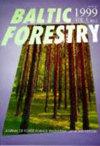土耳其东北部卡拉达木山树种分布的地形控制
IF 0.6
4区 农林科学
Q3 FORESTRY
引用次数: 0
摘要
本研究旨在揭示位于Canik-Giresun山脉和Trabzon山脉遗址过渡地带的卡拉达木地块山地树种分布与地形变量之间的关系。独立t检验和主成分分析结果表明,东北栎(Carpinus orientalis)和栎树(Quercus pepeea)对湿干旱地区具有较高的生态耐受性,而在湿润地区限制了甜槠(Castanea sativa)的分布。尽管Alnus glutinosa、Fagus orientalis和Picea orientalis表现出相似的生态特征,但这些物种很可能会受到Canik-Giresun山脉降雨和Trabzon山脉高海拔雾气增加的影响。随着靠近海岸的次海拔地区城市化程度的提高,负面干预措施可能会将森林限制在不适合农业和定居的陡坡上。因此,分布在特拉布松山地遗址亚海拔地区的可向海岸下移的抗旱西尔松、抗旱归化刺槐和地中海气候特征树种松木,其环境变量的影响是显著的。鉴于目前的社会生态动态,特别是在山区,这是高度脆弱的景观;了解这些关系有助于指导该地区及周边地区未来适当的管理策略。关键词:黑海东部地区,环境变量,站点,独立t检验,主成分分析本文章由计算机程序翻译,如有差异,请以英文原文为准。
Topographic controls in the distributions of tree species on the Karadağ Massif, NE Turkey
In this study, it was aimed to reveal the relationships between the distribution of tree species in the mountainous land on the Karadağ massif located in the transition zone of the Canik-Giresun mountains and the Trabzon mountains sites, and topographic variables. Results of independent t-test and PCA (Principal Component Analysis) indicated that Carpinus orientalis and Quercus petraea showed high ecological tolerance to humid-drought sites, whereas it limited the distribution of Castanea sativa in more humid areas. Although Alnus glutinosa, Fagus orientalis and Picea orientalis show similar ecological characteristics, it is likely that these species will be affected by the rainfall on the Canik-Giresun mountains along with the increasing fog in the upper altitudes of the Trabzon mountains. With increasing urbanization in sub-altitudes close to the coast, negative interventions may limit forests to steep slopes that are unsuitable for agriculture and settlement. Therefore, the drought-resistant Pinus sylvestris that can go down to the coast, the drought-resistant naturalized Robinia pseudoacacia, and Pinus pinea that is characteristic tree of the Mediterranean climate, which are distributed in the sub-altitudes of the Trabzon mountains site, are remarkable in terms of the impact of environmental variables. Given the current social-ecological dynamics, particularly in mountainous areas, which are highly fragile landscapes; understanding these relationships can help to guide appropriate future management strategy in the area and around. Key words: Eastern Black Sea region, environmental variables, sites, independent t-test, PCA
求助全文
通过发布文献求助,成功后即可免费获取论文全文。
去求助
来源期刊

Baltic Forestry
农林科学-林学
CiteScore
1.60
自引率
0.00%
发文量
23
审稿时长
>12 weeks
期刊介绍:
The journal welcomes the original articles as well as short reports, review papers on forestry and forest science throughout the Baltic Sea region and elsewhere in the area of boreal and temperate forests. The Baltic Sea region is rather unique through its intrinsic environment and distinguished geographical and social conditions. A temperate climate, transitional and continental, has influenced formation of the mixed coniferous and deciduous stands of high productivity and biological diversity. The forest science has been affected by the ideas from both the East and West.
In 1995, Forest Research Institutes and Universities from Estonia, Latvia and Lithuania
joined their efforts to publish BALTIC FORESTRY.
 求助内容:
求助内容: 应助结果提醒方式:
应助结果提醒方式:


